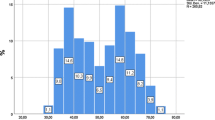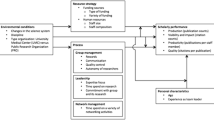Abstract
The main purpose of this paper is to explore why publication records differ among Dutch departments of economics. The results of a large scale performance evaluations have been used for classifying research units in subsamples of high and low performers. After collecting data on organizational characteristics of economics research units, univariate and multivariate statistics have been applied to test hypotheses regarding determinants of scientific productivity in economics.
“The extreme clannishness, not to say xenophobia, of the Econ makes life among them difficult and perhaps even somewhat dangerous for the outsider. This probably accounts for the fact that the Econ have so far not been systematically studied (...) More research on this interesting tribe is badly needed”.
Similar content being viewed by others
References
Verkenningscommissie Economische Wetenschappen (VEW), Academisch economisch onderzoek in Nederland: productie, productiviteit en profilering. Endrapport van de VEW, s-Gravenhage; Staatsuitgeverij, 1986.
P.E. Graves, J.R. Marchand, R. Thompson, Economics Departmental Rankings: Research Incentives, Constraints, and Efficiency,American Economic Review, 5, 1982 1131–41.
S.J. Liebowitz, J.P. Palmer, Assessing the Relative Impacts of Economic Journals,Journal of Economic Literature, 77–88.
J.S. Cramer, Een academische verkenning van het universitaire economische onderzoek,ESB, 8, 1986 838–40.
J.S. Cramer, De productiviteit van Economische Vakgroepen nader bezien,Kwantitatieve Methoden, 29, 1988 5–12.
J. Pen, Prioriteiten in het economisch onderzoek. In:Visies op onderzoek in enkele sociale wetenschappen,A.D. Wolff-Albers, H.F.M. Crombag, Preadviezen ten behoeve van de beleidsnota Maatschappij-en Gedragswetenschappen, 's-Gravenhage, 1982, pp. 25–40.
P. Nukamp (Ed.),Naar een meet-en monitoringsysteem van productiviteit/kwaliteit van het onderzoek in de Economische Faculteiten, Rapport Ad Hoc Commissie Voorzitters Vaste Commissie Wetenschapsbeoefening, Utrecht: VSNU.
D. Pelz, F.M. Andrews,Scientists in Organizations. Prodictuve Climates for Research and Development, New York, London, and Sydney; John Wiley, 1976.
Th. Allen,Managing the Flow of Technology, Boston; MIT Press, 1977.
F.M. Andrews (Ed.),Scientific Productivity. The Effectiveness of Research Groups in Six Countries, Cambridge and Paris; Cambridge University Press/UNESCO, 1979.
R.T. Keller, Predictions of the Performance of Project Groups in R&D Organizations,Academy of Management Journal, 4, (1986) 715–26.
R.K. Bresser, R.L.M. Dunbar, Context, Structure, and Academic Effectiveness: Evidence from West Germany,Organization Studies, 1, (1986) 1–24.
Y.W. Bally, J.F.A. Spangenberg, R. Starmans,Achtergrouden van de kwaliteit van het patientgebonden onderzoek in Nederland, s-Gravenhage; Staatsuitgeverij, 1987.
J.F.A. Sangenberg,Competitive Advantages and Scientific Productivity, Mimeo, Maastricht, Faculteit der Economische Wetenschappen, 1989.
G.J. Stigler, The Economics of Scale,Journal of Law and Economics, 1 (1958) 54–71.
P.A. Samuelson,Economics, McGraw-Hill, Tokyo, 1980.
O.E. Williamson,Markets and Hierarchies. Analysis and Antitrust Implications, New York; Free Press, 1980.
T.J. Peters, R.H. Waterman,In Search for Excellence: Lessons from America's Best Run's Companies, New York; Harper & Row, 1982.
W. Baumol, J.C. Panzar, R.D. Willig,Contestable Markets and the Theory of Industry Structure, New York; Harcourt Brace Jovanovich, 1982.
P. Van Cayseele, Spillovers and the Cost of Multiproject R & D,Managerial and Decision Economics, 7, 1986 133–39.
F. Prakke,The Management of the R & D-Marketing Interface and Its Effect on Successful Technological Innovation in Large Industrial Innovations, Ph.D. Thesis, Boston; MIT, 1974.
G.H. Hofstede,Culture's Consequences: International Differences in Work-Related Values, Beverly Hills; Sage, 1980.
A.H. Van De Ven, D.C. Ferry,Measuring and Assessing Organizations, New York; John Wiley.
P. Kunst,An Operationalization of Control in Organizational Research, Working paper 86-10, Maastricht; Faculteit der Economische Wetenschappen, 1986.
F.J.N. Nujhuis, J.F.A. Spangenberg,The Impact of Interdisciplinarity on Research Performance. Mimeo, Maastricht; Faculteit der Economische Wetenschappen, 1986.
Author information
Authors and Affiliations
Rights and permissions
About this article
Cite this article
Spangenberg, J.F.A., Buijink, W. & Alfenaar, W. Some incentives and constraints of scientific performance in departments of economics. Scientometrics 18, 241–268 (1990). https://doi.org/10.1007/BF02017764
Received:
Issue Date:
DOI: https://doi.org/10.1007/BF02017764




